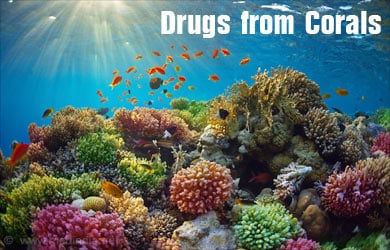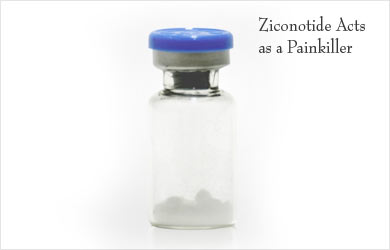- Corals and Their Potential Applications to Integrative Medicine - (http://dx.doi.org/10.1155/2014/184959)
- Are corals animals or plants? - (http://oceanservice.noaa.gov/facts/coral.html)
What are Corals?
The large expanse of seas and oceans hides many mysteries. Most of marine ecosystem remains unexplored despite several new advances in technology. While the ocean may house several living and non-living matter that could be dangerous to humans, it also has several bioactive compounds that could be immensely useful to mankind.
Images from under the sea in tropical regions brought to us by deep-sea divers often reveal crystal-blue water with a beautiful and colorful seabed formed by corals. Our first impression is that these are colorful rocks with interesting shapes. However, corals have a life of their own. The corals are formed by tiny organisms called polyps that attach themselves to the seabed. The polyps secrete limestone, which accumulates over ages to form the coral reefs. Algae called zooxanthellae are also found in coral reefs, which provide nutrition to the corals, give them color and remove wastes. When the algae die, the corals appear white. Several organisms, fish, sponges etc. inhabit the coral ecosystem.

Drugs from Corals
Corals are found relatively close to the coastlines, which has stimulated a lot of research on these organisms. There is on-going research in the pharmaceutical industry to explore the possibility of coral reefs to be used as a drug resource and provide us with molecules that can be used in the treatment of various conditions, especially for those ailments for which we currently have limited or no viable treatment options. Several organisms from the corals are being used in traditional medicine for a wide variety of illnesses. Several are being tested - the list is exhaustive. Initial research has provided interesting results. Some of the potential uses of corals are in the following conditions:
- Cancer: The anticancer properties of molecules obtained from corals is particularly attractive. Certain molecules extracted from the coral Sinularia have demonstrated anti-cancer effects. In addition, molecules isolated from other corals like Sarcophyton, Lobophytum michaelae, and Nephthea chabrolii also have anticancer properties.

- Dental procedures: Corals could provide certain materials that are used in dental procedures but are often in short supply. However, since corals have a high dissolution rate, they need to be strengthened with other material for this purpose.
- Inflammatory disease: Some molecules obtained from corals have been demonstrated to have anti-inflammatory properties. The anti-inflammatory effects of corals could possibly find its usefulness in rheumatoid arthritis. Some of the current drugs used in rheumatoid arthritis I are toxic in some patients while the newer ones are extremely expensive. Therefore, drugs obtained from corals could be useful in this condition.
- Bone disease: Studies in animals have shown that corals may be useful in preventing and treating bone loss in menopause. The limestone skeletons have a potential use as scaffolds in fractures around which bone can heal.
- Pain: Several molecules from corals are being investigated for their use in neuropathic or nerve-related pain.
- Parkinson’s disease: The molecule 11-dehydrosinularolide obtained from a coral could protect the brain against the damaging effects of inflammation and apoptosis, which is seen in Parkinson’s disease. Currently, the course of Parkinson’s disease is downhill and in the later stages, the patient is fully dependent on the caregiver. Thus, any drug that could be of use in prolonging the course of the disease would be of help.

- Antibacterial effect: Corals are sometimes attacked by bacteria. They therefore associate themselves with certain other bacteria that produce antibacterial substances against the pathogenic bacteria. These antibacterial substances could possibly be exploited and developed as new antibiotics for bacterial diseases.
- Hypertension: Coral sand is a rich source of silicon and could be possibly useful in hypertension.
- Cosmetic purposes: A sunscreen has been developed from molecules obtained from coral. Corals produce a substance which has a sunscreen-like effect to protect themselves from the ultraviolet rays of the sun. This substance is extracted from the corals for use in sunscreens.
Drugs obtained from Marine Sources
It is interesting to note that several drugs from marine sources are already in use. These include:
- Cytarabine, is a drug that was obtained from marine sponge from the Caribbean reefs. It is used for certain blood cancers.
- The antiviral drugs vidarabine and azidothymidine, which are obtained from marine sponges. Azidothymidine is effective against AIDS/HIV infection
- Trabectedin, which is obtained from a Caribbean tunicate. It is used for certain cases of advanced soft-tissue sarcoma and recurrence of ovarian cancer.
- Ziconotide, which is a drug that is obtained from a marine cone snail and is FDA-approved in chronic pain that does not respond to other painkillers. It is injected into the space between the spinal cord and its surrounding sheaths.

Coral reefs are currently endangered due to climate change, pollution, tourism, use of corals for traditional medicine etc. However, if we lose the coral reefs, we are likely to lose a potential source of medicines that could probably cure a lot of diseases. This is of course just one of the reasons why conservation of coral reefs is the need of the hour.





